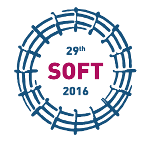Speaker
Rafał Krawczyk
(Institute of Electronic Systems)
Description
The development of GEM detector based acquisition systems resulted in the increase of throughput and resolution in the new revision of the system. The FPGA-based electronics is used to acquire, diagnose and to preliminarily analyze the data of soft X-ray emitted by hot plasma in Tokamak. Moreover, the development of electronics allowed to implement algorithms, so far performed offline after the experiment. Post-processing analysis consisted of calculating temporal, spatial and electric charge distribution in the detector. Due feasibility study with subsequent implementation were performed to assess the achievable throughput at which the data can be post-processed. The primary objective was to enhance the functionality of plasma detection systems and, subsequently, to enhance the capabilities of plasma control mechanisms with the introduced systems. The study concerns the implementation of stand-alone version of algorithms developed by the authors for the plasma diagnostics. The choice of hardware and overview of implementation issues is presented. Previous study concerning achieving speedup in MATLAB and overview of hardware of PCIe cards and processors continued, which led to justification of choosing optimal solution for a stand- alone application on PC responsible for on-line analysis of data with highest throughput. Implementation based on Intel Intel Xeon multicore CPU was further investigated. The resulting speedup is given as compared to previous MATLAB implementations.
The optimal implementation is presented with conclusions for further research and for with presenting further steps which should be undertaken to achieve higher throughput.
Co-authors
Andrzej Wojenski
(Institute of Electronic Systems, Faculty of Electronics and Information Technology, Warsaw University of Technology, Warsaw, Poland)
Grzegorz Kasprowicz
(Institute of Electronic Systems, Faculty of Electronics and Information Technology, Warsaw University of Technology, Warsaw, Poland)
Krzysztof Pozniak
(Institute of Electronic Systems, Faculty of Electronics and Information Technology, Warsaw University of Technology, Warsaw, Poland)
Maryna Chernyshova
(Institute of Plasma Physics and Laser Microfusion, 23 Hery Street, Poland)
Paweł Linczuk
(Institute of Electronic Systems, Faculty of Electronics and Information Technology, Warsaw University of Technology, Warsaw, Poland)
Paweł Zienkiewicz
(Institute of Electronic Systems, Faculty of Electronics and Information Technology, Warsaw University of Technology, Warsaw, Poland)
Piotr Kolasinski
(Institute of Electronic Systems, Faculty of Electronics and Information Technology, Warsaw University of Technology, Warsaw, Poland)
Rafał Krawczyk
(Institute of Electronic Systems, Faculty of Electronics and Information Technology, Warsaw University of Technology, Warsaw, Poland)
Ryszard Romaniuk
(Institute of Electronic Systems, Faculty of Electronics and Information Technology, Warsaw University of Technology, Warsaw, Poland)
Tomasz Czarski
(Institute of Plasma Physics and Laser Microfusion, 23 Hery Street, Poland)
Wojciech Zabołotny
(Institute of Electronic Systems, Faculty of Electronics and Information Technology, Warsaw University of Technology, Warsaw, Poland)

